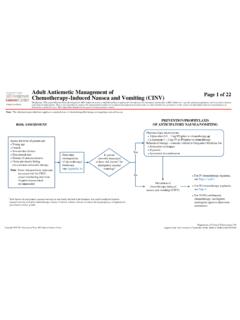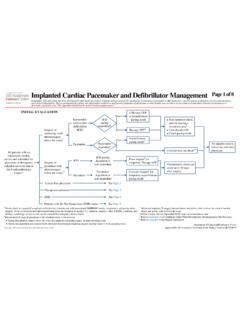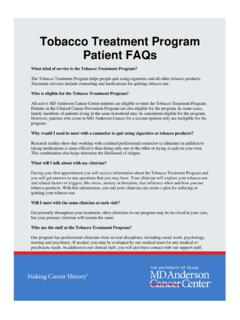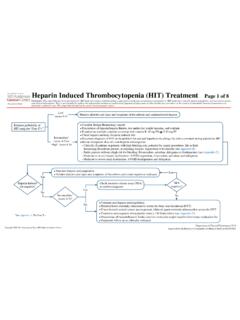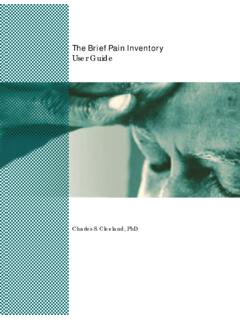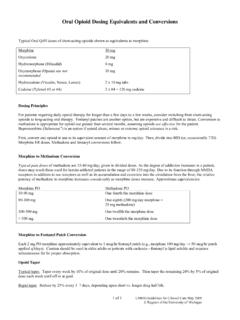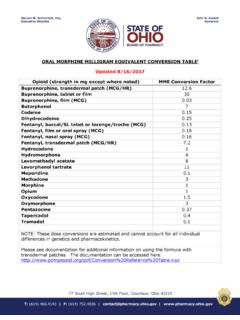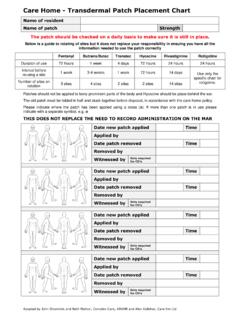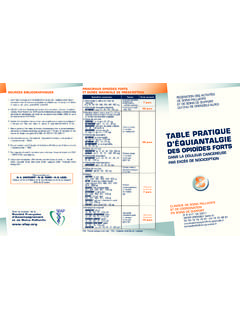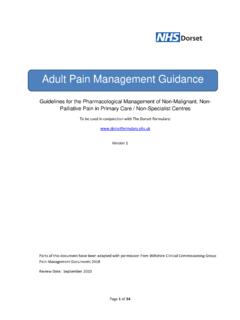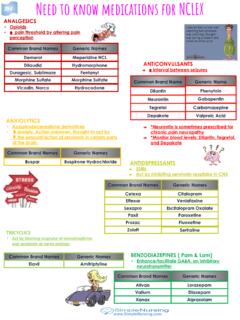Transcription of Peri-Operative Pain Management Page 1 of 21
1 Page 1 of 21 Disclaimer: This algorithm has been developed for MD Anderson using a multidisciplinary approach considering circumstances particular to MD Anderson s specific patient population, services and structure, and clinical information. This is not intended to replace the independent medical or professional judgment of physicians or other health care providers in the context of individual clinical circumstances to determine a patient's care. This algorithm should not be used to treat pregnant pain ManagementDepartment of Clinical Effectiveness V4 Approved by the Executive Committee of the Medical Staff on 10/20/2020 TABLE OF CONTENTSPost- operative pain Assessment and Treatment ..Pages 2-3 Quick Reference 4 APPENDIX A: Comprehensive pain Assessment ..Page 5 APPENDIX B: Non-Opioids .. Page 6 APPENDIX C: Opioid Dose Considerations ..Pages 7-8 APPENDIX D: Opioid Side Effects Prevention and Management .
2 Pages 9-10 APPENDIX E: Adjuvants Co-analgesics for Neuropathic pain Syndromes and Chronic pain .. Pages 11-12 APPENDIX F: Post-Op Specialty Services and Consultations Guidelines ..Page 13 APPENDIX G: Patient Controlled Analgesia (PCA) .. Page 14 APPENDIX H: Equianalgesic Opioid Dose Conversion .. Pages 15-16 APPENDIX I: Treatment .. Page 17 APPENDIX J: fentanyl .. Pages 18-19 Suggested Readings ..Page 20 Development Credits ..Page 21 Note: This consensus algorithm excludes patients who are in the ICU, perioperative or pre-procedural settings, or are currently receiving epidural or intrathecal discharge planNoYes Continue monitoring Re-evaluate at appropriate intervalsPain controlled?NoYesPre- operative Evaluation Comprehensive pain assessment (see Appendix A) Determine category of procedure (minor, intermediate, major)and consider the following treatment modalities: Minor: local anesthetic infiltration, post- operative oral analgesics Intermediate: minor recommendations in addition to regionalanalgesic technique if applicable and plan for possibleintravenous analgesics post-operatively Major: intermediate recommendations in addition to benefitof starting preoperative medications if appropriate Determine previous exposure to narcotics Anesthesia assessment for PNC or epidural Consider Acute pain consult if clinically indicatedPost- operative Evaluation Complications of surgery and/or anesthesia Comprehensive pain assessment (see Appendix A) Procedures performed Physical constraints (tight straps, bandages, excessivecompression, etc.)
3 Drain output (increased output may indicate coagulopathy) Swelling/edema Neurovascular assessment Activity restrictions/changes (ambulation, performance status,incentive spirometry, bowel function, etc.) Current pain orders: PCA, epidural, PNC, or other Consider Acute pain consult if clinically indicated Consider Physical Therapy/Occupational Therapy consult ifclinically indicated Consider Integrative Medicine consult if indicatedPain controlled?Per surgical and anesthesia teams,is there a need for post- operative Acute pain consult?NoYesConsult Acute pain See Page 3 See Page 3 ASSESSMENTPNC = peripheral nerve catheterPCA = patient controlled analgesiaPage 2 of 21 Disclaimer: This algorithm has been developed for MD Anderson using a multidisciplinary approach considering circumstances particular to MD Anderson s specific patient population, services and structure, and clinical information.
4 This is not intended to replace the independent medical or professional judgment of physicians or other health care providers in the context of individual clinical circumstances to determine a patient's care. This algorithm should not be used to treat pregnant pain ManagementNote: This consensus algorithm excludes patients who are in the ICU, perioperative or pre-procedural settings, or are currently receiving epidural or intrathecal of Clinical Effectiveness V4 Approved by the Executive Committee of the Medical Staff on 10/20/2020 TREATMENTR eassess pain and opioid side effects at appropriate intervals as clinically indicatedNoYesPain score1 3 and/or PPG metFor patients not currently taking opioids: Choose non-opioids (see Appendix B) or if contraindicated, useweak opioids (see Appendix C), as needed for painFor patients currently taking opioids: Continue current analgesic regimen if no side effects.
5 Prescribeshort-acting opioid at 10-20% of long-acting dose every 2 to 4 hoursas needed (Appendix C for dosing) Manage opioid induced side effects and decrease/change opioids ifindicated (see Appendix D)For patients not currently taking opioids: Administer short acting opioids (see Appendix C)Note: fentanyl should not be used in opioid na ve patientsFor patients currently taking opioids: Consider increasing scheduled opioid dose by 30-50%;calculate short-acting opioid dose as 10-20% of prior 24 hour opioid dose Manage opioid induced side effects and decrease/change opioids ifindicated (see Appendix D) Consider Acute pain consultManage both pain and psychosocial distress: Rapidly titrate short-acting opioids If significant anxiety related to pain , administer opioids prior to sedatinganxiolytics Ongoing assessment is necessary for pain , distress and opioid side effectsuntil patient stable Consider Acute pain consultSevere Pain2 pain not controlledContinue current treatmentConsult Acute Pain1 See Appendix A2 Severe pain , new onset, or exacerbation of previously stabilized pain , accompanied by significant distress or if present for > 24 hoursPain controlled?
6 Note for all patients: If patient has a regional anesthetic block, notify appropriate managing service Consider using appropriate adjuvants (see Appendix E), prevention and Management of opioid side effects (see Appendix D) and/or Integrative Medicine Services such as acupuncture or mind-body therapies (see Appendix F), Physical Therapy, patient education, and psychosocial support as appropriate If frequent prn doses required and pain anticipated for greater than one day, consider patient controlled analgesia (PCA). See Appendix score1 4 and/or PPG not metPPG = personalized pain goalNote: This consensus algorithm excludes patients who are in the ICU, perioperative or pre-procedural settings, or are currently receiving epidural or intrathecal 3 of 21 Disclaimer: This algorithm has been developed for MD Anderson using a multidisciplinary approach considering circumstances particular to MD Anderson s specific patient population, services and structure, and clinical information.
7 This is not intended to replace the independent medical or professional judgment of physicians or other health care providers in the context of individual clinical circumstances to determine a patient's care. This algorithm should not be used to treat pregnant pain ManagementDepartment of Clinical Effectiveness V4 Approved by the Executive Committee of the Medical Staff on 10/20/2020 Page 4 of 21 Disclaimer: This algorithm has been developed for MD Anderson using a multidisciplinary approach considering circumstances particular to MD Anderson s specific patient population, services and structure, and clinical information. This is not intended to replace the independent medical or professional judgment of physicians or other health care providers in the context of individual clinical circumstances to determine a patient's care. This algorithm should not be used to treat pregnant pain ManagementQuick Reference Guide Opioid na ve: Includes patients who are not chronically receiving opioid analgesic on a daily basis and therefore have not developed significant tolerance Opioid tolerant: Patients who are chronically receiving opioid analgesics on a daily basis.
8 The FDA identifies this group as receiving at least 60 mg of morphine daily, at least 30 mg of oraloxycodone daily, or at least 8 mg of oral hydromorphone daily or an equianalgesic dose of another opioid for a week or longer. Incomplete cross-tolerance: Reduce dose of new opioid by 30 to 50% when switching from one opioid to another to account for tolerance to a currently administered opioid that does not extend completely to other opioids. Consequently, this phenomenon tends to lower the required dose of the new opioid. Dose titration: Adjusting the dose of an opioid should be individualized for each patient. Refer to Page 3 of this algorithm for titration recommendations. Dosing frequency: For long-acting opioids, dosing frequency is typically every 12 hours to every 24 hours depending on the agent. Refer to Appendix C for Opioid Dose Considerations.
9 Breakthrough pain : Doses of short-acting opioids for breakthrough pain should be 10 to 20% of the total daily dose given every 1 to 4 hours as needed. Breakthrough opioids can be given asfrequently as every 1 hour for oral doses or every 15 minutes if intravenous (assuming normal renal/hepatic function). Elderly and/or organ dysfunction: Use additional caution when converting opioids in elderly patients (65 years and older), and/or patients with hepatic, renal, or pulmonary dysfunction. Codeine, morphine, hydromorphone, and oxycodone should be used with caution in patients with decreased renal function. Opioids NOT recommended for cancer pain : Meperidine and mixed agonist-antagonists (pentazocine, nalbuphine, butorphanol) should be avoided. Withdrawal symptoms: Nausea, vomiting, diarrhea, anxiety, and shivering are common symptoms of opioid withdrawal. A gradual taper is recommended when discontinuing opioids.
10 Overdose: Symptoms may include respiratory depression, constricted pupils, and decreased responsiveness. Naloxone is used to reverse the effects of an opioid. To administer, dilute mg/mL (1 mL) ampule into 9 mL of normal saline for total volume of 10 mL to achieve a mg/mL concentration, and give 1 mL ( mg) via slow intravenous push every 2 to 3 minutes until patient more awake and respiratory status improves. DO NOT administer undiluted due to risk of precipitating rapid withdrawal, which may cause severe pain or seizures. Constipation is a common side effect with opioid use. Consider starting a bowel regimen in all patients taking opioids. Refer to Appendix D. Duration of drug effect: Any residual drug in the patient s system must be accounted for and an assessment of any residual effects from discontinued long-acting opioids must be made beforeany new opioid is started.

